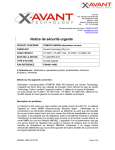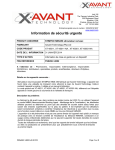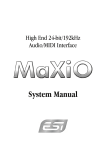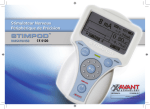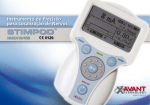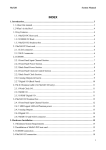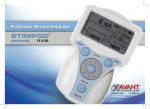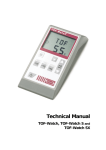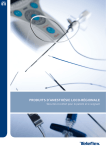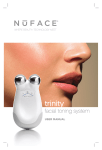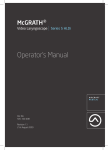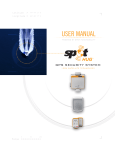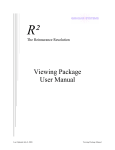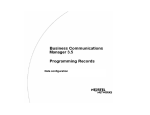Download STIMPOD NMS410/450 Instructions for Use
Transcript
Manufacturer Warnings: • Read the entire User Manual before attempting to use the device. • Use of cables or accessories other than those supplied with the STIMPOD may result in serious injury. • Maintenance on this device may only be performed by the manufacturer or persons explicitly authorized by the manufacturer. • Do not use the STIMPOD in close proximity to equipment that produces strong electromagnetic fields, such as high frequency surgical equipment. The cable leads could act as antennae and dangerous currents could be induced as a result. • Do not apply the STIMPOD to patients with implanted electrical devices, such as cardiac pacemakers, without first consulting with an appropriate medical specialist. • The device should not be used adjacent to or stacked with other equipment and that if adjacent or stacked use is necessary, the device should be observed to verify normal operation in the configuration in which it will be used. • The patient should avoid contact with metallic objects that are grounded, produce an electrical conductive connection with other equipment and/or enable capacitive coupling. • The cables should be positioned in such a way that they do not contact either the patient or other cables. • Simultaneous connection of a patient to high frequency surgical ME equipment and the STIMPOD may result in burns and possible damage to the stimulator. • Operation in close proximity (e.g. 1m) to a shortwave or microwave therapy ME equipment may produce instability in the stimulator output. • Application of electrodes near the thorax may increase the risk of cardiac fibrillation. Xavant Technology PTY (LTD) Unit 102, The Tannery Industrial Park, 309 Derdepoort Rd Silverton, Pretoria, South Africa, 0184 Tel: +27 (0) 12 743 5959 Fax: +27 (0) 86 547 0026 E-mail:[email protected] Web:www.xavant.com Legal Representative in the EU Emergo Europe 15 Molenstraat, 2513 BH, The Hague The Netherlands Caution Federal (US) law restricts this device to sale by or on the order of a physician. Indications for use: This product is a nerve stimulation device designed to be used by an anaesthetist during • General Anaesthesia, for the purpose of establishing the efficacy of a Neuromuscular Blocking Agent using non-invasive surface electrodes (not supplied) (NMS450). •• Regional Anaesthesia for the purpose of • Nerve mapping using the non-invasive Nerve Mapping Probe (supplied). • Nerve locating using invasive electrodes/needles (not supplied). Cautions: • Prior to changing the batteries be sure to switch off the device and remove all the cables. • Remove elements which may adversely affect the connection between the electrodes and the skin, e.g., dirt, hair, oil. • Ensure that ECG electrodes are not damaged or dried out. • Large current densities associated with failing ECG electrodes may cause superficial burns. Contraindications: • Infection of the puncture site. • Known neurological disorders. • Severe coagulation disorders. i • The Stimpod is designed to be compatible with a standard ECG electrode, however, for high currents the use of a dedicated NMBA electrode such as the Xavant XT45008 (-NA) is recommended. • Electrodes that have current densities exceeding 2mA/cm2 may require special attention of the operator. • This product must be stored at 0 – 50°C. • This product must be transported in the carry case provided. • This product and all the accessories have been certified latex free. Warranty: • The Stimpod (device only) carries a 24 Month Warranty against defects, provided that the device was used in accordance with the operating instructions. • The cables included in the Stimpod Kit carry a 6 Month Warranty against defects, provided that they were used in accordance with the operating instructions. • The Stimpod enclosure should not be opened under any circumstances. Opening the unit will void the warranty. STIMPOD (NMS410/450) conforms to the following standards: • IEC 60601-1, IEC 60601-2-10 • IEC 60601-1-2: CISPR 11 Group1 class A; IEC 61000-4-2; IEC 61000-4-3 • ISO 13485, Directive 93-42-EEC ii Guidance and manufacturers declaration – electromagnetic emissions– for all equipment and systems The STIMPOD NMS410/NMS450 is intended for use in electromagnetic environment specified below. The customer or user of the STIMPOD NMS410/NMS450 should assure that it is used in such an environment Emission Test Compliance Electromagnetic Environment – Guidance RF Emissions CISPR 11 Group 2 – Class A The STIMPOD NMS410/NMS450 must emit electromagnetic energy in order to perform its intended function. Nearby electronic equipment may be affected. The STIMPOD NMS410/NMS450 is suitable for use in all establishments, other than domestic establishments and may be used in domestic establishments and those directly connected to the public low voltage power supply network that supplies buildings used for domestic purposes, provided the following warning is heeded: WARNING: This equipment/system is intended to be used by healthcare professional only. This equipment/system may cause radio interference or disrupt the operation of nearby equipment. It may be necessary to take mitigation measures, such as re-orienting or re-locating the STIMPOD NMS410/ NMS450 or shielding the location Guidance and manufacturers declaration – electromagnetic immunity- for all equipment and systems The STIMPOD NMS410/NMS450 is intended for use in the electromagnetic environment specified below. The customer or the user of the STIMPOD NMS410/NMS450 should assure that it is used in such an environment Immunity Test IEC 60601 test level Compliance level Electromagnetic environment - guidance Electrostatic discharge (ESD) IEC 61000-4-2 ± 6 kV contact ± 8 kV air ± 6kV contact ± 8kV Air Floors should be wood, concrete or ceramic tile. If the floors are covered with synthetic material, the relative humidity should be at least 30% Power frequency (50/60 Hz) magnetic field IEC 61000-4-8 3 A/m 50 Hz 3 A/m (Effective) Power frequency magnetic fields should be at levels characteristic of a typical location in a typical commercial or hospital environment. iii Guidance and manufacturer’s declaration – electromagnetic immunity The STIMPOD NMS410/NMS450 is intended for use in the electromagnetic environment specified below. The customer or the user of the STIMPOD NMS410/NMS450 should assure that it is used in such an environment. Immunity test IEC 60601 test level Compliance level Electromagnetic environment – guidance Portable and mobile RF communications equipment should be used no closer to any part of the STIMPOD NMS410/NMS450, including cables, than the recommended separation distance calculated from the equation applicable to the frequency of the transmitter. Recommended separation distance Conducted RF IEC 61000-4-6 3 Vrms 150 kHz to 80 MHz Not applicable Radiated RF IEC 61000-4-3 3 V/m 80 MHz to 2,5 GHz 3 V/m d = 1,2 80 MHz to 800 MHz d = 2,3 800 MHz to 2,5 GHz where P is the maximum output power rating of the transmitter in watts (W) according to the transmitter manufacturer and d is the recommended separation distance in metres (m). Field strengths from fixed RF transmitters, as determined by an electromagnetic site survey, a should be less than the compliance level in each frequency range. Interference may occur in the vicinity of equipment marked with the following symbol: NOTE 1 NOTE 2 a At 80 MHz and 800 MHz, the higher frequency range applies. These guidelines may not apply in all situations. Electromagnetic propagation is affected by absorption and reflection from structures, objects and people. Field strengths from fixed transmitters, such as base stations for radio (cellular/cordless) telephones and land mobile radios, amateur radio, AM and FM radio broadcast and TV broadcast cannot be predicted theoretically with accuracy. To assess the electromagnetic environment due to fixed RF transmitters, an electromagnetic site survey should be considered. If the measured field strength in the location in which the STIMPOD NMS410/NMS450 is used exceeds the applicable RF compliance level above, the STIMPOD NMS410/ NMS450 should be observed to verify normal operation. If abnormal performance is observed, additional measures may be necessary, such as re-orienting or relocating the STIMPOD NMS410/NMS450. iv Recommended separation distances between portable and mobile RF communications equipment and the STIMPOD NMS410/NMS450 The STIMPOD NMS410/NMS450 is intended for use in an electromagnetic environment in which radiated RF disturbances are controlled. The customer or the user of the STIMPOD NMS410/ NMS450 can help prevent electromagnetic interference by maintaining a minimum distance between portable and mobile RF communications equipment (transmitters) and the STIMPOD NMS410/NMS450 as recommended below, according to the maximum output power of the communications equipment. Rated maximum output power W Separation distance according to frequency of transmitter m 150 kHz to 80 MHz 80 MHz to 800 MHz 800 MHz to 2,5 GHz Not applicable d = 1,2 d = 2,3 0,01 - 0,12 0,23 0,1 - 0,38 0,73 1 - 1,2 2,3 10 - 3,8 7,3 100 - 12 23 For transmitters rated at a maximum output power not listed above, the recommended separation distance d in metres (m) can be estimated using the equation applicable to the frequency of the transmitter, where P is the maximum output power rating of the transmitter in watts (W) according to the transmitter manufacturer. NOTE 1 NOTE 2 At 80 MHz and 800 MHz, the separation distance for the higher frequency range applies. These guidelines may not apply in all situations. Electromagnetic propagation is affected by absorption and reflection from structures, objects and people. Guidance and manufacturers declaration – electromagnetic immunity – for equipment and systems that are nonlife supporting The STIMPOD NMS410/NMS450 is intended for use in the electromagnetic environment specified below. The customer or the user of the STIMPOD NMS410/NMS450 should assure that it is used in such an environment Immunity Test IEC 60601 test level Compliance level Electromagnetic environment - guidance Radiated immunity 80MHz - 2.5GHz 80MHz – 1GHz @ 3V/m & 10V/m 1GHz – 2.5GHz @ 10V/m 80MHz – 1GHz @ 3V/m & 10V/m 1GHz – 2.5GHz @ 10V/m Portable and mobile RF communications equipment can affect MEDICAL ELECTRICAL EQUIPMENT and should be used no closer to any part of the equipment, including cables, than the recommended separation distance. v Contents Page 1. 1 Getting to know the STIMPOD (NMS 410/450) 1.1) Device Description 1.2)Accessories 1.3) Device Layout 1.4) Screen Layout 1.5) Warning Screens 1.6) Open Circuit Detection 1.7) Auto Shutdown 1.8) Symbols on device battery clip 1 2 3 4 5 6 6 6 2. Operating Device in Nerve Locating Mode (NMS 410/450) 7 2.1) 2.2) 2.3) 2.4) Proximity Indicator Adjusting the Current Adjusting the Pulse Width Adjusting the Twitch Frequency 7 8 8 8 3. Operating Device in Nerve Mapping/Locating Mode (NMS 410/450) 3.1) Adjusting the Current 3.2) Adjusting the Pulse Width 3.3) Adjusting the Twitch Frequency Page 4.6) 4.7) 4.8) 4.9) 4.10) 4.11) 4.12) Train of Four Mode (TOF) Double Burst Mode (DB) Post Tetanic Count Mode (PTC) Refractory Period Delay Twitch Mode Tetanus Mode Single Stimulus vs. Repeated Stimulation 12 13 13 13 14 14 14 5. Setting up Device Defaults 5.1)Languages 5.2) Current Mode 5.3) Pulse Width Options 5.4) Stimulating Frequency 5.5) Repeat Timer TOF, DB, PTC (NMS450) 5.6) Refractory Period Timer TOF, DB, PTC (NMS450) 5.7) Proximity Indicator 5.8) Speaker Volume 5.9)Backlight 5.10) User Information 9 10 10 10 6. Technical Notes 6.1) Performance Testing 6.2)Specifications 6.3) Cleaning and Disinfecting STIMPOD 4. Operating Device in Neuromuscular Blocking Agent 11 (NMBA) Monitoring Mode (NMS 450) 7. Products & Accessories 4.1) Electrode Placement 11 4.2) 4.3) 4.4) 4.5) Accelerometer Placement Adjusting the Current Adjusting Stimulation Mode Adjusting the Twitch/ Tetanus Frequency 11 12 12 12 vi 15 15 16 18 18 18 19 19 20 20 20 21 21 23 23 24 1) Getting to know the STIMPOD (NMS 410/450) 1.1) Device Description The STIMPOD (NMS 410/450) is a precision nerve locating tool used for localizing specific neural pathways. Localization of nerves by electrical stimulation involves connecting the nerve stimulator to a conducting needle through which local anaesthetics can be injected. The distance of the needle (cathode) from the nerve can be estimated by establishing the minimum threshold current required, to facilitate a neuromuscular response. The STIMPOD (NMS 450) includes Neuromuscular Blocking Agent Monitoring functionality with real-time feedback achieved by tri-axial accelerometry. CAUTION: This device should only be used by a qualified physician with appropriate knowledge in anaesthesia. CAUTION: The sale or purchase of the device is restricted to licensed medical practitioners, as governed by the law of the country/state in which he/she practices, or where the device is to be used. 1 1.2)Accessories WARNING: Use of cables or other accessories other than those supplied with the STIMPOD may result in serious injury. NOTE: Electrodes and Nerve Locating needles are not included in this package. CAUTION: A sterile wipe should be applied to the Nerve Mapping Probe prior to use. Nerve Locating Cable: • This cable is used to activate the Nerve Locating mode on the STIMPOD. • The red (anode) connector is designed to clip on to a standard ECG electrode. • The 2mm needle connector will accommodate various makes of needles. Nerve Mapping/ Nerve Locating Cable: • This cable is used to activate the Nerve Mapping/ Nerve Locating mode on the STIMPOD. • The red (anode) connector is designed to clip on to a standard ECG electrode. • The ergonomically designed cutaneous Nerve Mapping Probe presents the user with a simple and reliable Nerve Mapping solution. • The 2mm needle connector will accommodate various makes of needles. NMBA Monitoring Cable (NMS450): • This cable is used to activate the NMBA mode on the STIMPOD. • The red (anode) and black (cathode) connectors are designed to clip onto the Xavant NMBA electrode (XT45008) (-NA) or onto a standard ECG electrode. • The accelerometer is designed to attach to the contracted appendage (in the case of the ulnar nerve, this will be the thumb). Carry Case Batteries: • This unit uses 4 x AAA penlight batteries. • Lithium batteries are recommended. • When the battery is depleted the unit will prompt the user to replace the battery and switch off. • Switch device off and remove all cables before replacing battery. • Remove battery if the device is not to be used for an extended period of time, to prevent leakage. WARNING: If battery acid has leaked into the device essential circuitry may have been compromised. In the event of leakage the device must be returned to its manufacturer for safety checks and possible repairs. 2 1.3) Device Layout Cable Connector • Insert the Nerve Locating Cable, the combined Nerve Mapping / Locating Cable or the NMBA cable to activate the relevant mode. Display Multi Functional Clip Enter / Frequency Button • Press to toggle between Frequencies. • Press to Enter in setup menu. Menu / Pulse Width Button NMS410/450 (LOC/MAP Mode) • Press to toggle between Pulse Widths. • Press and hold to access Setup Menu. NMS 450 (NMBA Mode) • Press to toggle between Stimulation Modes. Stimulating LED indicator • Flashing Green: Stimulus delivered. • Flashing Red: Open Circuit. Pause Button NMS 410/450 (LOC/MAP Mode) • Press to Stop / Start Stimulation. NMS 450 (NMBA Mode) • Press and release to elicit a single stimulation. • Press and hold to activate a repeated stimulation. The Wheel • Adjust current in the main operating mode. • Navigate the Setup Menus. Battery Compartment Cover On / Off Button • Press to switch unit on / off. 3 1.4) Screen Layout Indicators Nerve locating mode Nerve mapping mode NMBA mode (NMS450) Non-Linear mode Linear mode Speaker Volume Battery Status Warning Main Screen Notifies the user of a discrepancy between current setting and average current of actual stimulus. • Current Setting Adjust using Wheel. • Diagnostic or Warning Screen • Average current of actual stimulus • Pulse Width Setting Adjust using Menu / Pulse Width button. Warning Screens • NMBA Mode (NMS 450) Stimulation Mode TOF, DB, PTC, TET, TWI. • Stimulating Frequency Setting Adjust using Enter / Hz button. Explained on Page 5. Diagnostic Screen NMS 450 (NMBA Mode) Diagnostic Screen NMS 410 / 450 (LOC / MAP Mode) • Countdown timer • Real-time feedback of for repeat mode relative contraction strength measured with the accelerometer • Calculated • Proximity indicator arrow Charge Setting • Indication of current setting • 0 mA • Graph indicating shape of actual current stimulus • Calculated percentage in TOF and DB mode • Twitch Count in PTC and TOF if less than 4 contractions were indentified • Average charge of actual stimulus 4 1.5) Warning Screens Insert Cable: This is the first prompt which the user will encounter as the unit is switched on, and signals that the unit is waiting for the cable to be inserted. Pause: This warning informs the user that the PAUSE button was pressed. The STIMPOD will pause all its activities and wait for the PAUSE button to be pressed again. Cable not recognised: This warning informs the user that the inserted cable is not compatible with the NMS 410/450. Replace Batteries: This warning informs the user that the batteries are depleted beyond an acceptable level. Continuing to operate the device thus will make it unreliable. To prevent this the STIMPOD flashes this warning for 4 seconds before switching off. Open Circuit Detected: This warning informs the user that the two electrodes (i.e. ECG electrode and needle or mapping device) do not form a closed circuit. This warning will be accompanied by a red flashing LED, every time the unit attempts to stimulate. Current Adjustment in NMBA Mode: When attempting to adjust the current while in NMBA mode the device will show this message, requesting the user to confirm the adjustment of the current. Refractory Delay Active Press Enter To Confirm Refractory Delay Active: Once a TOF, DB, or PTC stimulation is performed, the refractory period timer is initiated. During the countdown time it will not be possible to perform another stimulation. If another stimulation is attempted, this warning screen will appear. Component Error: The STIMPOD has detected a component failure. Please send the device back to the manufacturer for repair! 55 1.6) Open Circuit Detection The Stimpod performs impedance measurements at regular intervals to detect whether the connection between the STIMPOD and the patient comprises a closed circuit. Closed Circuit Detected: Open Circuit Detected: • Stimulation will take place. • Stimulating sound will be heard (Single or multiple beeps depending on proximity indicator setting. Sound pitch will follow the current intensity). •The LED stimulus indicator will pulse green with every successful stimulus attempt. •The diagnostic screen will provide active feedback on every pulse delivered. • No stimulation will take place. • No stimulating sound will be heard. •The LED stimulus indicator will pulse red with every unsuccessful stimulus attempt. •A warning screen will appear in the diagnostics screen indicating that an open circuit was detected. 1.7) Auto Shutdown STIMPOD will shutdown after 10 minutes of no user or patient interaction. 1.8) Symbols on device battery clip Manufacturer Type BF Applied Part Caution Separate collection for electrical and electronic equipment (Applicable to EU community only) Consult instructions for use 6 Manufacturing Date (Year) Serial Number Representative in the EU 2) Operating Device in Nerve Locating Mode (NMS 410/450) Localisation of nerves by electrical stimulation involves connecting the nerve stimulator to a conducting, locating needle (not supplied) through which local anaesthetics can be administered. This procedures involves subcutaneous stimulation of the motor component of the relevant peripheral nerve, to ‘locate’ the nerve. • Select this mode by inserting the Nerve Locating cable. • The STIMPOD will automatically default to the Nerve Locating current range (0.00 - 5.00 mA) and display the ‘ LOC ’ indicator. 2.1) Proximity Indicator The proximity indicator is activated when the combination of current and pulse width settings result in a charge which is within the range as selected in the SETUP MENU, section 5.7. Visual Indication: • Visually indicated in the diagnostics screen by two arrowheads. • Arrowhead indicating the lower threshold points upwards. • Arrowhead indicating the upper threshold points downwards. •The dotted line representing the selected current will be positioned between the two arrowheads if the target charge range is entered. Audible Indication: • A successful stimulus above the proximity range will make a single beep. • A successful stimulus within the proximity range will make a double beep. • A successful stimulus below the proximity range will make a triple beep. 77 2.2) Adjusting the Current Current Mode Options: Sound: Options in the Setup Menu: Linear Mode, Non-Linear Mode Default: Linear If sound is enabled: STIMPOD will beep every time that a stimulus was delivered. The pitch of the sound will follow the current intensity level. Linear Mode: Non-Linear Mode: The Linear Mode is called linear because one ‘click’ on the Wheel will correspond with one increment as set in the specific current range. The Linear Mode allows the user to select individual incrementing options for the three different current ranges. The Non-Linear Mode facilitates the non-linear nature of the current intensity versus the distance from the nerve. This mode allows the user to define 20 adjustment positions in terms of Current (mA) and Pulse Width (ms). If correctly implemented each adjustment position should afford the user with a relatively linear progression in terms of the distance from needle tip to the nerve. Default Current range: 0.00 - 5.00mA adjustable in the following default increments: 0.0 - 0.6mA Default 0.1mA 0.6 - 2.0mA Default 0.2mA 2.0 - 5.0mA Default 0.5mA Default Current and Pulse Width Range: As shown in table 5.1 in section 5.2 circle the Wheel to select the predetermined current and pulse width positions sequentially. Increments can be adjusted in the Setup Menus (refer to 5.2) NOTE: Because the 20 definable positions include both current and pulse width settings, pulse width cannot be adjusted independently in this mode. This is indicated on the screen by the fact that pulse width is not highlighted. Circle the Wheel to adjust current. Warning Notifies the user of a discrepancy between current setting and average current of actual stimulus. Average of actual current delivered. 2.3) Adjusting the Pulse Width 2.4) Options in the Setup Menu: 0.05ms, 0.1ms, 0.3ms, 0.5ms, 1ms Default: 0.1ms, 0.3ms Press Menu/Pulse Width button to toggle between different Pulse Widths. Adjusting the Twitch Frequency Options in the Setup Menu: 1Hz, 2Hz, 5Hz Default: 2Hz Press Enter/Hz button to toggle between different stimulating frequencies. 8 3) Operating Device in Nerve Mapping/Locating Mode (NMS 410/450) Percutaneous nerve mapping enables the anaesthesiologist to map out a particular superficial nerve prior to nerve location with the needle. This is accomplished by stimulating the motor component of the relevant peripheral nerve percutaneously with the nerve mapping probe. This technique ensures a higher success rate for directing the needle to the correct nerve. This mode offers the user the means to do nerve mapping and locating without having to switch or unplug cables. When inserting the Nerve Mapping / Locating Cable, the STIMPOD will default to the Nerve Mapping current range (0-20mA). Current will be directed to the Nerve Mapping probe and the STIMPOD will attempt to stimulate. The moment that the needle penetrates the skin the cable will sense it and inform the STIMPOD. The STIMPOD will switch to Nerve Locating mode and behave as described in chapter 2. If contact between the needle and patient is broken, and the nerve mapping probe touches the patient, STIMPOD will switch back to the nerve mapping mode and start monitoring the needle - patient connection again. Whenever the nerve mapping probe and the nerve locating needle simultaneously make contact with the patient the needle will have first priority. • This mode is selected when the Nerve Mapping / Locating cable is inserted. 99 When using the Nerve Mapping Probe (NMS 410/450): Sound: •The STIMPOD will automatically default to the Nerve Mapping current range (0-20mA) and display the ‘ MAP ’ indicator. 3.1) If sound is enabled: STIMPOD will beep every time that a stimulus was delivered. The pitch of the sound will follow the current intensity level. Adjusting the Current Average of actual current delivered. Current Range: 0 - 20mA adjustable in 1mA increments. Circle the Wheel to adjust current. Warning Notifies the user of a discrepancy between current setting and average current of actual stimulus. 3.2) Adjusting the Pulse Width 3.3) Options in the Setup Menu: 0.05ms, 0.1ms, 0.3ms, 0.5ms, 1ms Default: 0.1ms, 0.3ms Press Menu/Pulse Width button to toggle between different pulse widths. Adjusting the Twitch Frequency Options in the Setup Menu: 1Hz, 2Hz, 5Hz Default: 2Hz Press Enter/Hz button to toggle between different stimulating frequencies. When using the Nerve Locating Needle: • Connect the needle to the Nerve Mapping/Locating cable. The moment that the needle penetrates the skin the cable will communicate this to the STIMPOD, switch to nerve locating mode, and switch the stimulation to the needle. The current in locating mode will default to 0.00mA. • The STIMPOD will now function exactly as described in Chapter 2. • If contact between the needle and patient is broken, and the nerve mapping probe touches the patient, STIMPOD will switch back to the nerve mapping mode and start monitoring the needle - patient connection again. Mapping mode will default back to 0mA. • Whenever the nerve mapping probe and the nerve locating needle simultaneously make contact with the patient the needle will have first priority. 10 4) Operating Device in Neuromuscular Blocking Agent Monitoring Mode (NMS 450) Monitoring Neuromuscular Blocking Agents involves stimulating a neural pathway which facilitates the contraction of an appendage. Based on the relative strength of contraction which is the result of a stimulus of specific intensity or waveform, it is possible to draw conclusions about the efficacy of an injected Neuromuscular Blocking Agent. • This mode is selected when the NMBA cable is inserted. 4.1) Electrode Placement 4.2) Accelerometer Placement 4.1.1) Anatomical stimulation sites are chosen based on: • their accessibility during surgery • the ability to observe the neuromuscular response • the nerve should be a suitable distance from the responding muscle to prevent direct muscle stimulation The tri-axial accelerometer should be attached to the contracting appendage of the patient, to measure the strength of the contraction resulting from the applied electrical stimulus. The accelerometer is only used in the Train-of-Four, Double Burst and Post Tetanic Count Modes, to facilitate monitoring of the efficacy of the Neuromuscular Blocking Agent. 4.1.2) Anatomically ideal stimulation sites: Targeted Nerve Affected Muscle Contracting Appendage Ulnar nerve adductor pollicis muscle Thumb Posterior tibial nerve flexor halluces brevis muscle Big toe Facial nerve (Zygomatic Branch) orbicularis oculi muscle Eye lid Facial nerve (Temporal Branch) corrugator supercili muscle Eye brow Electrode placement relies on the cathode (black electrode clip) to be as close to the targeted nerve as possible in order to effectively depolarize the nerve. The anode (red electrode clip) should be away from the targeted nerve. 11 11 When using the Neuromuscular Blocking Agent Monitoring Mode (NMS 450): 4.3) Adjusting the Current Sound: If sound is enabled: STIMPOD will beep every time that a stimulus was delivered. The pitch of the sound will follow the current intensity level. When attempting to adjust the current in NMBA mode the Stimpod will show a message requesting to confirm the adjustment of current. When this message appears, press the ‘enter’ button. This will cause the current intensity to flash on and off, which means that the current can now be adjusted. Average of actual current delivered. Warning Notifies the user of a discrepancy between current setting and average current of actual stimulus. If current has not been adjusted for more than 2 seconds, the current will be set. Default Current range: 0 - 80 mA adjustable in 5mA increments. Circle the Wheel to adjust current. 4.4) 4.6) Adjusting Stimulation Mode The TOF stimulation comprises four, square waves with a pulse width of 200 microseconds, 500 milliseconds apart. Options: TOF, DB, PTC, TET, TWI Default: TOF Press Menu/Mode button to toggle between different Stimulation Modes. 4.5) Train of Four Mode (TOF) Selecting TOF Mode: • Insert the NMBA cable with the red and black electrode clips as well as the tri-axial accelerometer. • Press the ‘Mode’ button until ‘TOF’ is shown on the display. Adjusting Twitch/Tetanus Frequency Twitch Mode: Real-time Accelerometry: • The relative contraction strength caused by each stimulus is indicated graphically in the diagnostic screen as shown in the picture. • In the case that all four contractions could be measured, the percentage of measured contraction strength of the fourth stimulus compared to the first stimulus will be displayed in the diagnostic screen. • If less than four contractions were measurable, the number of contractions that could be identified by the accelerometer will be displayed, e.g., 2/4. Options in the Setup Menu (Stimulating Frequency): 1Hz, 2Hz, 5Hz Default: 2 Hz Press Enter/Hz button to toggle between different stimulation frequencies. Tetanus Mode: Options: 50Hz, 100Hz Default: 50Hz Press Enter/Hz button to toggle between different stimulating frequencies. 12 4.7) Double Burst Mode (DB) 4.8) Post Tetanic Count (PTC) The DB stimulation comprises a burst of three square waves of 200 microseconds pulse width, 20 milliseconds apart, followed by another burst of three square waves, 750 milliseconds later. Defaults: Tetanus: 50Hz for 5 seconds Delay: 3 seconds Twitch: 20 twitches at 1Hz Selecting DB Mode: • Insert the NMBA cable with the red and black electrode clips as well as the tri-axial accelerometer. • Press the ‘Mode’ button until ‘DB’ is shown on the display. The PTC stimulation comprises a tetanus stimulation followed by a delay and a number of twitches. (Default settings are as shown above) Selecting PTC Mode: • Insert the NMBA cable with the red and black electrode clips as well as the tri-axial accelerometer. • Press the ‘Mode’ button until ‘PTC’ is shown on the display. Real-time Accelerometry: • The relative contraction strength caused by each stimulus is indicated graphically in the diagnostic screen as shown in the picture. • The percentage of the measured contraction strength of the second contraction compared to the first contraction will be displayed in the diagnostic screen. 4.9) Real-time Accelerometry: • Each counted twitch is indicated graphically in the diagnostic screen as shown in the picture. The number of twitches counted are displayed in the diagnostic screen. Refractory Period Delay The three modes: TOF, DB and PTC are subject to refractory period delays, providing a safety period which prevents the user from repeating stimulation while the nerve synapse is recovering from the effects of the previous stimulation. Immediately after stimulation in one of these modes, the countdown timer is activated and shown on the screen. If repeat mode is activated, only the repeat timer will be displayed on the screen because the repeat period for the repeat timer will always be larger than the refractory period timer. If an attempt is made to stimulate while the refractory timer is active a warning screen will be displayed reminding the user that the refractory period is active. Default refractory period delays are as follows for the three modes: TOF: 15 seconds DB: 1 minute PTC: 2 minute 13 4.10) Twitch (TWI) 4.11) Tetanus (TET) Defaults: Repeat at 2Hz Adjustable:1Hz, 2Hz and 5Hz Defaults:50Hz (adjustable to 100Hz) The Tetanus stimulation comprises series of 200 microseconds square wave pulses repeated at a 50Hz or 100Hz repetition rate or frequency. The Twitch stimulation comprises a 200 microseconds square wave pulse. If the ‘Play/Pause’ button is pressed the twitch will repeat at the selected frequency. Selecting TET Mode: • Insert the NMBA cable with the red and black electrode clips as well as the tri-axial accelerometer. • Press the ‘Mode’ button until ‘TET’ is shown on the display. Selecting TWI Mode: • Insert the NMBA cable with the red and black electrode clips as well as the tri-axial accelerometer. • Press the ‘Mode’ button until ‘TWI’ is shown on the display. Stimulate/Stop: Start stimulation by holding the ‘Play/Pause’ button down. Stop stimulation by releasing the ‘Play/Pause’ button. Stimulate/Stop: Start stimulation by pressing the ‘Play/Pause’ button. Stop stimulation by pressing the ‘Play/Pause’ button again. Frequency adjustment: Press the ‘Hz’ button to toggle through the frequencies. 4.12) Single Stimulus vs. Repeated Stimulation • • • • • Start the automatic repeat mode by holding the play/pause button down for longer than 2 seconds. The device will automatically start a countdown according to the ‘repeat timer’ setting as specified in the main menu for each respective mode’s timer. The countdown will be indicated next to the clock symbol shown in the diagnostic screen. Disable the automatic repeat mode by pressing and holding the play/pause button again. The Repeat Timer for each mode defaults at 2 minutes and can be changed in the menu. 14 5) Setting up Device Defaults (NMS 410/450) Access the Setup Menu by pressing and holding the Menu/Pulse Width Button. The setup menu allows the user to customise all the default settings. SETUP MENU 1 LANGUAGE 2 CURRENT MODE 3 PULSE WIDTH 4 FREQUENCY 5 REPEAT TIMER TOF 6 REPEAT TIMER DB 7 REPEAT TIMER PTC 8 REFRACTORY TIME TOF 9 REFRACTORY TIME DB 10 REFRACTORY TIME PTC 11 PROXIMITY INDICATOR 12 SPEAKER VOLUME 13BACKLIGHT 14 USER INFORMATION EXIT 5.1) Languages DEFAULT: English Use the Wheel to navigate to LANGUAGE. Press enter to select. To select another default language, use the Wheel to navigate to the preferred language. Press enter to select. The radio button next to the selected language will show that it is activated. To exit scroll down the menu to EXIT MENU and press enter. A confirmation screen will show your selection, with an option to ACCEPT. YES will take you back to the main Setup Menu. NO will take you to the previous screen. Note: The NMS410 does not have the REPEAT TIMER or REFRACTORY TIMER options. 15 15 5.2) Current Mode The first range will be: 0.00mA - 0.60mA. In this range the user can select one of the following increment options: 0.01mA, 0.02mA, 0.05mA and 0.1mA. The default setting is: 0.05mA. Select the desired increment and proceed to NEXT RANGE. DEFAULT: Linear Mode Options: Linear Mode, Non-Linear Mode Linear Mode The second range will be 0.6mA - 2.0mA. In this range the user can select one of the following increment options: 0.05mA. 0.1mA and 0.2mA. The default setting is: 0.1mA. Select the desired increment and proceed to NEXT RANGE. The ` ` indicator in the main window tells the user that the device is in Linear Mode. The linear mode is called linear because one ‘click’ on the wheel will correspond with one increment as set in the specific current range. In the linear mode, Pulse Width is not affected when turning the wheel. Pulse Width is selected when the Menu/Pulse Width button is pressed. The Linear Mode essentially allows the user to select three different increment options for three different current ranges. The third range will be: 2.0mA - 5.0mA. In this range the user can select one of the following increment options: 0.1mA, 0.2mA and 0.5mA. The default setting is: 0.2mA. Select the desired increment and proceed to EXIT MENU. Use the Wheel to navigate to CURRENT MODE. Press enter to select. Use the Wheel to navigate to Current Mode. Press enter to select. The radio button next to Linear Mode will show that it is activated. To exit scroll down the menu to EXIT MENU and press enter. A confirmation screen will show your selection, with an option to ACCEPT. YES will take you back to the main Setup Menu. NO will take you back to Linear Mode settings. A confirmation screen will show your selection, with an option to ACCEPT. Non - Linear Mode YES will take you to the next screen. NO will take you to the Current Mode Menu. The ` ` indicator in the main menu window tells the user that the device is in Non-Linear Mode. The Non-Linear Mode facilitates the non-linear nature of the current intensity versus the distance from the nerve. The required current intensity is proportional to the square of the distance from the electrode to the nerve fibre. This mode allows the user to define 20 adjustment positions in terms of Current (mA) and Pulse Width (ms). If correctly implemented each adjustment position should afford the user a relatively linear progression in terms of the distance from needle tip to the nerve. The defaults are indicated in table 5.1. A graph of table 5.1 is shown in figure 5.1. The next screen will enquire whether the user would like to change the settings. YES will take you to the next screen. NO will take you back to the main Setup Menu. 16 Position Current (mA) Pulse Width (ms) Charge (µC) 1 0.3 0.1 0.03 2 0.43 0.1 0.043 3 0.58 0.1 0.058 4 0.76 0.1 0.076 5 0.97 0.1 0.097 6 1.2 0.1 0.12 7 1.4 0.1 0.14 8 1.7 0.1 0.17 9 2 0.1 0.2 10 2.3 0.1 0.23 11 2.7 0.1 0.27 12 3 0.1 0.3 13 3.4 0.1 0.34 14 3.8 0.1 0.38 15 4.3 0.1 0.43 16 4.8 0.1 0.48 17 1.8 0.3 0.54 18 2.1 0.3 0.63 19 2.4 0.3 0.72 20 2.7 0.3 0.81 It should be noted that the charge of the default values shows a typical quadratic curve. At a pulse width of 0.1ms the current follows the charge. 1 2 3 4 5 6 Charge 7 8 9 10 11 12 Current 13 14 15 16 17 18 19 20 Pulse Width Figure 5.1 Once a limit of 5mA is reached the pulse width is increased to 0.3ms. After 0.3ms the slope of the charge on the graph is increased. NOTE: Each position in this adjustment mode can be defined individually. The user is advised to experiment and adjust the values in order to meet clinical expectations. NOTE: In this mode the Pulse Width is preset and linked to a specific position. When operating the device in this mode the Pulse Width button is deactivated. All positions are accessed sequentially by manipulating the wheel. Use the Wheel to navigate to CURRENT MODE. Press enter to select. To adjust the default position values, use the Wheel to navigate to Non-Linear Mode. Press enter to select. The radio button next to Non-Linear will show that it has been activated. A Confirmation screen will show your selection with an option to ACCEPT. Table 5.1 YES will take you to the next screen. NO will take you back to the Current Mode Menu. 17 17 The next screen will enquire whether the user would like to change the settings. To change the default pulse widths, use the Wheel to navigate to PULSE WIDTH in the main menu. Press enter to select. The radio button next to the selected pulse width will show that they have been activated. YES will take you to a screen showing all the positions and their values. NO will take you back to the main Setup Menu. To exit scroll down the menu to EXIT MENU and press enter. A confirmation screen will show your selection, with an option to ACCEPT. YES will take you back to the main Setup Menu. NO will take you back to the previous screen. All positions will be shown with their respective current and pulse width settings. Scroll down to the position that needs to be adjusted and press enter. When entering the screen the current setting will be highlighted. Adjust to the required value and press enter. Next the pulse width setting will be highlighted. Adjust to the required value and press enter. The STIMPOD will calculate and display the charge as adjustments are made. NOTE: If all pulse widths are deselected the STIMPOD will default to 0.1ms and 0.3ms. 5.4) Stimulating Frequency DEFAULT: 2Hz Options: 1Hz, 2Hz and 5Hz NOTE: A warning will indicate if the net charge resulting from the user’s settings is either lower than the previous position or higher than the following position. To change the default frequency, use the Wheel to navigate to FREQUENCY in the main menu. Press enter to select. The radio button next to the selected frequency will show that it is has been selected. Scroll down the menu to EXIT MENU and press enter. Once a new current and pulse width setting has been entered for the relevant position, the device will again show all the positions and their values. The user can now adjust any other position values following the same steps. To exit, scroll down the menu and EXIT MENU and press enter. A confirmation screen will show your selection with an option to ACCEPT. A confirmation screen will draw a graph reflecting the net charge for every position, with an option to ACCEPT. YES will take you back to the main Setup Menu. NO will take you back to the screen showing all the positions with their respective current and pulse width settings. YES will take you back to the main Setup Menu. NO will take you back to the previous screen. 5.5) Repeat Timer TOF, DB, PTC (NMS450) 5.3) Pulse Width Options DEFAULT: 2 minutes for all three modes Options: Adjustable from 00:00 to 99:59 DEFAULT: 0.1ms, 0.3ms Options: 0.05ms, 0.1ms, 0.3ms, 0.5ms, 1.0ms This timer counts down the delay between repeated stimulations in TOF, DB and PTC modes when operating the device in NMBA mode. Use this setup function to activate the preferred pulse widths. 18 REPEAT TIMER TOF Adjust Range: Minutes: 01 Seconds:20 REPEAT TIMER TOF You have selected: 01:20 01 ACCEPT: YES NO 5.6) ‘Minutes’ will be highlighted: Use the Wheel to adjust the settings. Press enter to accept the desired setting. needle has reached the desired proximity to the nerve. This proximity is indicated both visually and audibly. ‘Seconds’ will be highlighted: Use the Wheel to adjust the settings. Press enter to accept the desired setting. Visually: In the diagnostics screen of the device, the dotted line will indicate the selected current level. The proximity range will be indicated by two arrowheads on the right hand side of the diagnostics screen. The arrow representing the lower threshold value will point up and the arrow representing the higher threshold value will point down. This offers the user visual feedback on the position of the current amplitude at a specific pulse width, relative to the defined proximity thresholds. NOTE: The proximity thresholds are defined in charge (Coulomb). A confirmation screen will show your updated values with an option to ACCEPT. YES will take you back to the main Setup Menu. NO will take you back to the previous screen. Refractory Period Timer TOF, DB, PTC (NMS450) DEFAULT: TOF 15 seconds, DB 1 minute, PTC 2 minutes Options: Adjustable from 00:00 to 99.59 Audibly: The STIMPOD has three different sound patterns when stimulating. A single beep means that the user is above the upper threshold of the proximity range. A double beep means that the user is in the proximity range. A triple beep means that the user is below the proximity range. To change the default Proximity Indicator Levels, use the Wheel to navigate to PROXIMITY INDICATOR in the main menu. Press enter to select. Choose On or Off by activating the correct radio button. To exit scroll down the menu to EXIT MENU and press enter. These three individual timers count down the refractory period delays for the three modes TOF, DB, PTC respectively. Their purpose is to prevent the user from repeating stimulation while the nerve synapse is recovering from the effects of the previous stimulation. REFRACTORY TIME TOF Adjust Range: Minutes: 04 Seconds:10 REFRACTORY TIME TOF You have selected: 04:10 01 ACCEPT: YES NO ‘Minutes’ will be highlighted: Use the Wheel to adjust the settings. Press enter to accept the desired setting. A confirmation screen will show your selection with an option to ACCEPT. ‘Seconds’ will be highlighted: Use the Wheel to adjust the settings. Press enter to accept the desired setting. YES will take you to the following menu. NO will take you back to the menu above. A confirmation screen will show your updated values with an option to ACCEPT. Here you have the option to adjust the proximity thresholds. YES will take you back to the main Setup Menu. NO will take you back to the previous screen. YES will take you to the thresholds adjustment menu. NO will take you back to the main Setup Menu. 5.7) Proximity Indicator The lower limit will be highlighted. Adjust using the adjusting wheel. Press enter to move on to the upper limit. Adjust the upper limit and press enter. DEFAULT: 30 - 60 nC The proximity indicator notifies the user that the target charge range has been reached. This function allows the user to set up an upper and lower limit of charge. When contraction is elicited, this indicator should indicate to the user that the 19 19 A confirmation screen will show your updated values with an option to ACCEPT. A confirmation screen will show your selection, with an option to ACCEPT. YES will take you back to the main Setup Menu. NO will take you back to the previous screen. YES will take you back to the main Setup Menu. NO will take you back to the previous screen. 5.8) Speaker Volume NOTE: If the selected backlight option is ‘Always On’ the battery life will be drastically shortened. The speaker volume offers 4 different options: OFF and 3 different volume settings. The different volume settings are indicated on the main screen as follows: 5.10) User Information DEFAULT: Medium DEFAULT: No default The STIMPOD offers the user the option to enter user information. Two lines of 20 characters each may be entered. This user information will be displayed for two seconds when unit is switched on, as per example. To change the speaker volume, use the Wheel to navigate to SPEAKER VOLUME in the main menu. Press enter to select. Use the wheel to select the appropriate volume and enter. Scroll down the menu to EXIT MENU and press enter. Use the Wheel to navigate to USER INFORMATION in the main menu. Press enter to select. A cursor will appear at the first character’s position. Use the Wheel to navigate to different characters. Press enter to select the character and move to the next space. A Confirmation screen will show the new selected volume with an option to ACCEPT. YES will take you to the main Setup Menu. NO will take you back to the previous screen. Press enter on the ‘ ‘ character for backspace, on the ‘ ’ character for a space and on the ‘ ‘ character to enter the line. 5.9) Backlight DEFAULT: 5 Seconds Options: OFF, 5 seconds, 60 seconds, and Always On A warning underneath the textbox will show the available characters in the line. To change the default Backlight setting, use the Wheel to navigate to BACKLIGHT in the main menu. Press enter to select. The radio button next to the selected setting will show that it has been activated. Scroll down the menu to EXIT MENU and press enter. When both lines have been entered, a confirmation screen will show your selection, with an option to ACCEPT. YES will take you back to the main Setup Menu. NO will take you back to the first USER INFORMATION screen. 20 6) Technical Notes 6.1) Performance Test Before operating and using the device a performance test must be carried out at the site of use. The performance test described below is in compliance with the German § 5 MPBetreibV directive. • • Insert the batteries and switch on the device. The following screen should appear on the display. • NMS4X0 VX.00 • • • User Information followed by _._ _ ! 6.1.1) • Short-circuit the needle connector and the ECG connector. The following screen should appear on the display. The LED should flash GREEN and if sound is enabled in the menu a beep should be heard each time a stimulus is delivered. Stimulus should occur at the set frequency. (1,2 or 5 Hz). Use the adjusting wheel and slowly increase the current to 5.00mA. Monitor that the stimulating waveform, measured and displayed in the diagnostic window is square. The top part of the square wave should also touch the dotted line, which represents the current setting as shown below. Insert InsertCable Cable Nerve Locating Mode Insert the Nerve Locating Cable. The following screen should appear on the display. 6.1.2) • 0.00 ! Combined Nerve Mapping/Nerve Locating Mode Insert the Combined Nerve Mapping/Nerve Locating Cable. The following screen should appear on the display. Open Circuit Open Circuit Detected Detected ! • Open Circuit Detected The LED should flash RED and no audible feedback should be heard. • 21 The LED should flash RED and no audible feedback should be heard. • Short-circuit the Nerve Mapping probe and the ECG connector. The following screen should appear on the display. • • Use the adjusting wheel and increase the current to 80mA. Press the ‘play/pause’ button while shaking the accelerometer. The NMS450 should respond as follows: • • • • • • • The LED should flash GREEN and if sound is enabled in the menu a beep should be heard each time a stimulus is delivered. Stimulus should occur at the set frequency. (1,2 or 5 Hz). Use the adjusting wheel and slowly increase the current to 20mA. Monitor that the stimulating waveform, measured and displayed in the diagnostic window is square. The top part of the square wave should also touch the dotted line, which represents the current setting as shown below. • In order to test the Nerve Locating connection and device functionality follow the instructions in 6.1.1. • 6.1.3)Neuromuscular Blocking Agent Mode (NMBA Mode) (NMS450 only) • • The LED should flash GREEN in accordance with the four stimulations. Each stimulation should be accompanied by an audible ‘beep’. In ‘Diagnostic window’ four bars of different heights should indicate that the accelerometer detected movement. Monitor the actual current delivered to ensure that the warning sign does not appear. Separate the red and black electrode connectors to cause an open circuit between them. Press the ‘play/pause’ button. The following screen should appear on the display. Insert the NMBA Cable. The following screen should appear on the display. ! ! • • Offener OpenStromkreis Circuit Detected erkannt Ensure that the device is in ‘TOF’ mode. Short-circuit the red and black electrode connectors. • The LED should flash RED and no audible feedback should be heard. • If the STIMPOD malfunctions in any one of these performance tests, it should be checked by the relevant technical department in accordance with the test instructions in the Technical Service Manual. Equipment may only be repaired by the manufacturer or by an organisation expressly authorised by the manufacturer. Equipment does not require regular calibration. • • 22 Offener OpenStromkreis Circuit Detected erkannt 6.2) Specifications Operating Modes: Nerve Locating Mode Nerve Mapping Mode NMBA Mode NMS 410/450NMS 410/450NMS 450 Current Range: 0.00 - 5.00 mA ± 5% 0 - 20mA ± 5% 0 - 80mA ± 5% Pulse Width Options: 0.05ms, 0.1ms, 0.3ms, 0.5ms, 1ms ± 5% 0.05ms, 0.1ms, 0.3ms, 0.5ms, 1ms ± 5% 0.2ms ± 5% Maximum Stimulation Voltage: 100V400V400V Stimulus: Monophasic square wave Monophasic square wave Monophasic square wave Stimulating Frequency: 1Hz , 2Hz, 5Hz ± 5% 1Hz , 2Hz, 5Hz ± 5% 1Hz, 2Hz, 5Hz, 50Hz, 100Hz ± 5% Load Impedance: 0 kOhm - 20 kOhm 0 kOhm - 20 kOhm 0 kOhm - 5 kOhm Technical Specifications NMS 410/450 Device Classification: Class IIa, Type BF Power Supply: 4 x AAA alkaline batteries Power Consumption: 17mA Waveform: Constant Current, Monophasic Square Wave Weight:130g Dimensions: 145mm x 90mm x 30mm Operating Temperature: 10 - 40 ° Celsius Storage and Transport Temperature:0 - 50 ° Celsius Operating Humidity: 90% Relative Humidity Transport and Storage Humidity: 90% Relative Humidity Operating Atmospheric Pressure: 50 – 106kPa Transport and Storage Atmospheric Pressure: 50 – 106kPa 6.3) Cleaning and Disinfecting STIMPOD NMS410/450 Cleaning: Soap and water, applied with a damp cloth is suitable to clean and disinfect the STIMPOD. It is imperative that no moisture penetrates the STIMPOD. Disinfecting: Any commercially available methanol - free disinfectant in an ethyl alcohol base can be used for disinfection. 23 7) Products & Accessories NMS 410 PERIPHERAL NERVE STIMULATOR ONLY Product Code: XT-41000 (-NA)* (No cables or accessories) NMS 410 PERIPHERAL NERVE STIMULATOR Product Code: XT-41001 (-NA)* (Including Probe, Locator, Carry Case, IFU) NMS 450 PERIPHERAL NERVE STIMULATOR ONLY Product Code: XT-45000 (-NA)* (No cables or accessories) NMS 450 PERIPHERAL NERVE STIMULATOR Product Code: XT-45011 (-NA)* (Including Probe, Locator, NMBA Cable with Accelerometer, Carry Case, IFU ) NERVE LOCATING CABLEProduct Code: XT-41003 (-NA)* NERVE LOCATING/MAPPING CABLEProduct Code: XT-41004 (-NA)* NMBA CABLE WITH ACCELEROMETER Product Code: XT-45015 (-NA)* POLYPROPYLENE CARRY CASEProduct Code: XT-41002 ACCELEROMETER STRAP (Pack of 5)Product Code: XT-45007 (-NA)* NMBA ELECTRODE (Pack of 10)Product Code: XT-45008 (-NA)* INSTRUCTIONS FOR USE Product Code: XT-45006-EN (Refer to www.xavant.com for additional languages) *North America only e.g. Product Code: XT-45005-NA 24 Unit 102, The Tannery Industrial Park, 309 Derdepoort Rd, Silverton, Pretoria, South Africa, 0184 Tel: +27 (0) 12 743 5959, Fax: +27 (0) 86 547 0026 E-mail: [email protected], Web: www.xavant.com
































